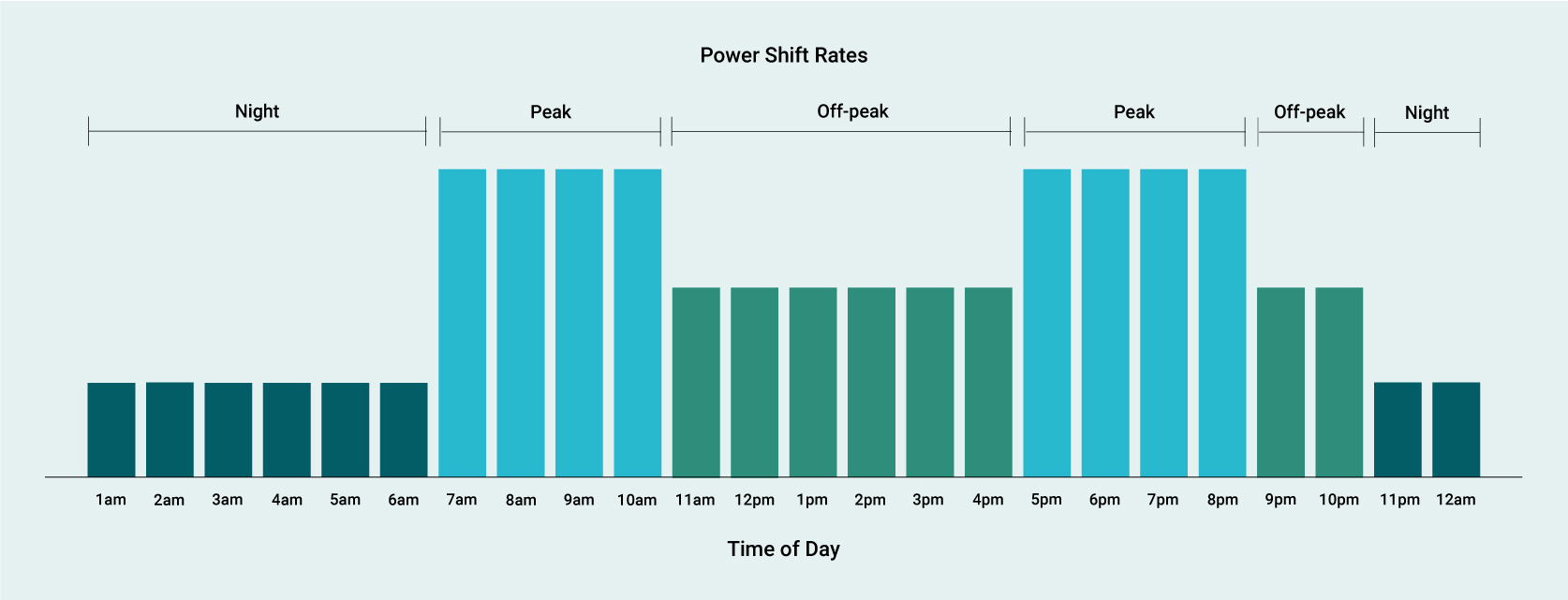Your Guide to Smarter Energy Habits with Power Shift

The Power Shift plan isn't about using less electricity, it's about using it smarter. If you shift your energy usage to off-peak, nights or weekends, you can take advantage of lower rates and you could reduce your energy costs.
Electricity rates on the Power Shift plan vary throughout the day. Rates are lower during off-peak hours, higher during peak times, and half-price power is available on weekends.
Customers who adjust their usage to take advantage of these off-peak and night rates can typically save around 20% on their power bills.*
If you don’t shift your usage accordingly, the Power Shift plan could end up costing more than our Grey Power plan. That’s why it’s important to choose the plan that fits your lifestyle.
The more you can shift your energy use to cheaper off-peak times, like overnight or on weekends, the more you could save.

Run Appliances Overnight
Cheapest time: 11pm – 7am (Night Rate)
Set your dishwasher, washing machine or dryer to run after 11pm or switch them on before you sleep. Night rates are the most affordable, and many modern appliances have delay timers or smartphone apps, meaning you can schedule them to run after bedtime and wake up with clean clothes and dishes for less.
Avoid Peak Hour Energy Traps
Peak Times: 7am - 11am & 5pm - 9pm
The mornings and early evenings are when electricity demand spikes due to increased demand on the grid. During these times, try to limit the usage of ovens, dryers, heaters, and other energy-hungry devices. If you're cooking dinner or using heating, consider pre-cooking or pre-heating during off-peak hours and reheating later or try using energy-efficient appliances like air fryers or microwaves.
Shift Power Use To The Weekend
Half Price Weekends: Midnight Friday – Midnight Sunday
Take advantage of Power Shift’s Half Price Weekends by moving as much of your power use as possible into Saturday and Sunday. Think of laundry days, batch cooking, vacuuming, even charging electric vehicles or power tools. Small changes like rescheduling chores can cut your weekday usage and reduce your overall bill.
Charge Your EV (or anything with a battery) at Night
Optimal: After 11pm
Electric vehicles, power banks, laptops, e-scooters, anything with a rechargeable battery is best plugged in after 11pm. This is when your rates are lowest, and if your EV has charging timers, set them up once and let automation save you money every night.
Keep Heat In
Best applied during cooler months and peak heating times. One of the easiest ways to save power (especially in winter) is to keep the warmth you’ve paid for inside your home. Heating is one of the biggest contributors to high power bills, especially during peak hours (7–11am and 5–9pm), when people are warming up in the morning or settling in for the evening.
Here’s how to stay warm without wasting energy:
- Close doors to unused rooms to prevent heat from escaping and reduce the area you need to warm.
- Seal gaps and stop drafts around windows, doors, and floors with draft stoppers or even rolled-up towels; this stops warm air from leaking out and cold air from creeping in.
- Use curtains wisely, open them during the day to let sunlight warm your space naturally, and close them before dark to trap the heat in.
- Position heaters efficiently, avoid placing them under windows or near drafts.
- Only heat the space you’re using and set thermostats to 18–20°C. Every degree higher can add significantly to your power bill.
- Use timers on heaters to avoid accidentally heating empty rooms during peak price windows.
*Actual savings may vary depending on usage patterns and appliance efficiency. Learn more.

Post your comment
Comments
No one has commented on this page yet.